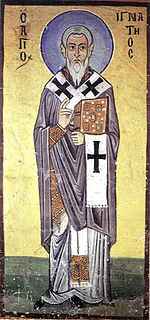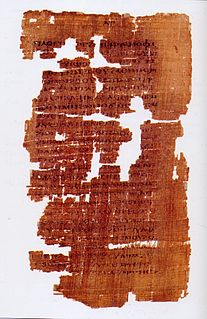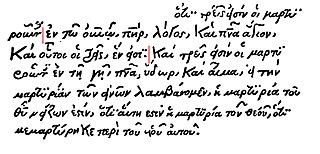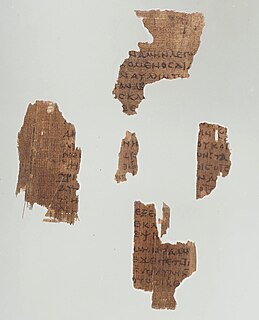Related Research Articles

The First Epistle of John, often referred to as First John and written 1 John or I John, is the first of the Johannine epistles of the New Testament, and the fourth of the catholic epistles. There is no scholarly consensus as to the authorship of the Johannine works. The author of the First Epistle is termed John the Evangelist, who most scholars believe is not the same as John the Apostle. Most scholars believe the three Johannine epistles have the same author, but there is no consensus if this was also the author of the Gospel of John.

Ignatius of Antioch, also known as Ignatius Theophorus, was an early Christian writer and Patriarch of Antioch. While en route to Rome, where he met his martyrdom, Ignatius wrote a series of letters. This correspondence now forms a central part of a later collection of works known to be authored by the Apostolic Fathers. He is considered to be one of the three most important of these, together with Clement of Rome and Polycarp. His letters also serve as an example of early Christian theology. Important topics they address include ecclesiology, the sacraments, and the role of bishops.

The New Testament (NT) is the second division of the Christian biblical canon. It discusses the teachings and person of Jesus, as well as events in first-century Christianity. The New Testament's background, the first division of the Christian Bible, is called the Old Testament, which is based primarily upon the Hebrew Bible; together they are regarded as sacred scripture by Christians.

The Epistle of Barnabas is a Greek epistle written between AD 70 and 132. The complete text is preserved in the 4th-century Codex Sinaiticus, where it appears immediately after the New Testament and before the Shepherd of Hermas. For several centuries it was one of the "antilegomena" writings that some Christians looked on as sacred scripture, while others excluded them. Eusebius of Caesarea classified it as such. It is mentioned in a perhaps third-century list in the sixth-century Codex Claromontanus and in the later Stichometry of Nicephorus appended to the ninth-century Chronography of Nikephoros I of Constantinople. Some early Fathers of the Church ascribed it to the Barnabas who is mentioned in the Acts of the Apostles, but it is now generally attributed to an otherwise unknown early Christian teacher, perhaps of the same name. It is distinct from the Gospel of Barnabas.

The Didache, also known as The Lord's Teaching Through the Twelve Apostles to the Nations, is a brief anonymous early Christian treatise written in Koine Greek, dated by modern scholars to the first or second century AD. The first line of this treatise is "The teaching of the Lord to the Gentiles by the twelve apostles". The text, parts of which constitute the oldest extant written catechism, has three main sections dealing with Christian ethics, rituals such as baptism and Eucharist, and Church organization. The opening chapters describe the virtuous Way of Life and the wicked Way of Death. The Lord's Prayer is included in full. Baptism is by immersion, or by affusion if immersion is not practical. Fasting is ordered for Wednesdays and Fridays. Two primitive Eucharistic prayers are given. Church organization was at an early stage of development. Itinerant apostles and prophets are important, serving as "chief priests" and possibly celebrating the Eucharist. Meanwhile, local bishops and deacons also have authority and seem to be taking the place of the itinerant ministry.

Philotheos Bryennios was a Greek Orthodox metropolitan of Nicomedia, and the discoverer in 1873 of an important manuscript with copies of early Church documents.
The Apostolic Fathers were core Christian theologians among the Church Fathers who lived in the 1st and 2nd centuries AD, who are believed to have personally known some of the Twelve Apostles, or to have been significantly influenced by them. Their writings, though widely circulated in Early Christianity, were not included in the canon of the New Testament. Many of the writings derive from the same time period and geographical location as other works of early Christian literature which came to be part of the New Testament. Some of the writings found among the Apostolic Fathers appear to have been as highly regarded as some of the writings which became the New Testament.

The New Testament apocrypha are a number of writings by early Christians that give accounts of Jesus and his teachings, the nature of God, or the teachings of his apostles and of their lives. Some of these writings have been cited as scripture by early Christians, but since the fifth century a widespread consensus has emerged limiting the New Testament to the 27 books of the modern canon. Roman Catholic, Eastern Orthodox, and Protestant churches generally do not view these New Testament apocrypha as part of the Bible.

The Codex Alexandrinus is a fifth-century Christian manuscript of a Greek Bible, containing the majority of the Greek Old Testament and the Greek New Testament. It is one of the four Great uncial codices. Along with the Codex Sinaiticus and the Vaticanus, it is one of the earliest and most complete manuscripts of the Bible. Brian Walton assigned Alexandrinus the capital Latin letter A in the Polyglot Bible of 1657. This designation was maintained when the system was standardized by Wettstein in 1751. Thus, Alexandrinus held the first position in the manuscript list.

Codex Ephraemi Rescriptus is a fifth-century Greek manuscript of the Bible, sometimes referred to as one of the four great uncials. The manuscript is not intact: in its current condition, Codex C contains material from every New Testament book except 2 Thessalonians and 2 John; however, only six books of the Greek Old Testament are represented. It is not known whether 2 Thessalonians and 2 John were excluded on purpose, or whether no fragment of either epistle happened to survive.
The Apostolic Constitutions or Constitutions of the Holy Apostles is a Christian collection divided into eight books which is classified among the Church Orders, a genre of early Christian literature, that offered authoritative "apostolic" prescriptions on moral conduct, liturgy and Church organization. The work can be dated from 375 to 380 AD. The provenance is usually regarded as Syria, probably Antioch. The author is unknown, although since James Ussher it has often considered to be the author of the letters of Pseudo-Ignatius, perhaps the 4th-century Eunomian bishop Julian of Cilicia.
The Apostolic Church-Ordinance is an Orthodox Christian treatise which belongs to genre of the Church Orders. The work can be dated at the end of 3rd century CE. The provenience is usually regarded as Egypt, or perhaps Syria. The author is unknown.

The First Epistle of Clement is a letter addressed to the Christians in the city of Corinth. Based on internal evidence some scholars say the letter was composed some time before AD 70, but the common time given for the epistle's composition is at the end of the reign of Domitian and AD 140, most likely around 96. It ranks with Didache as one of the earliest, if not the earliest, of extant Christian documents outside the traditional New Testament canon. As the name suggests, a Second Epistle of Clement is known, but this is a later work by a different author. Part of the Apostolic Fathers collection, 1 and 2 Clement are not usually considered to be part of the canonical New Testament.

A biblical manuscript is any handwritten copy of a portion of the text of the Bible. Biblical manuscripts vary in size from tiny scrolls containing individual verses of the Jewish scriptures to huge polyglot codices containing both the Hebrew Bible (Tanakh) and the New Testament, as well as extracanonical works.
The Codex Athous Laurae—designated by Ψ or 044 in the Gregory-Aland numbering, and δ 6 in von Soden numbering—is a manuscript of the New Testament written in Greek uncial on parchment. The manuscript is written in a mix of text styles, with many lacunae, or gaps, in the text, as well as containing handwritten notes, or marginalia.

Codex Montfortianus designated by 61, and known as Minuscule 61 is a Greek minuscule manuscript of the New Testament on paper. Erasmus named it Codex Britannicus. Its completion is dated on the basis of its textual affinities to no earlier than the second decade of the 16th century, though a 15th-century date is possible on palaeographic grounds. The manuscript is famous for including a unique version of the Comma Johanneum. It has marginalia.

Papyrus 6, designated by 𝔓6 or by ε 021, is a fragmentary early copy of the New Testament in Greek and Coptic (Akhmimic). It is a papyrus manuscript of the Gospel of John that has been dated paleographically to the 4th century. The manuscript also contains text of the First Epistle of Clement, which is treated as a canonical book of the New Testament by the Coptic Church. The major part of the codex is lost.

Minuscule 1739, α 78, is a Greek minuscule manuscript of the New Testament, on 102 parchment leaves. It is dated paleographically to the 10th century.
The Taktikon Uspensky or Uspenskij is the conventional name of a mid-9th century Greek list of the civil, military and ecclesiastical offices of the Byzantine Empire and their precedence at the imperial court. Nicolas Oikonomides has dated it to 842/843, making it the first of a series of such documents extant from the 9th and 10th centuries. The document is named after the Russian Byzantinist Fyodor Uspensky, who discovered it in the late 19th century in a 12th/13th-century manuscript in the library of the Eastern Orthodox Patriarchate of Jerusalem, which also contained a portion of the Kletorologion of Philotheos, a later taktikon.
Codex Sinaiticus Rescriptus mostly originating in Saint Catherine’s Monastery, Sinai is an accumulation of sixteen or even eighteen Christian Palestinian Aramaic palimpsest manuscripts containing Old Testament, Gospel and Epistles pericopes of diverse Lectionaries, various unidentified homilies and one by John Chrysostom, hagiographic texts as the Life of Pachomios, the Martyrdom of Philemon Martyrs, and the Catecheses by Cyril of Jerusalem. The manuscripts are recycled parchment material that were erased and reused by the tenth century Georgian scribe Ioane-Zosime for overwriting them with homilies and a Iadgari. Part of the parchment leaves had been brought by him from the Monastery of Saint Sabas, south of Jerusalem, when he moved to St Catherine’s Monastery and became there librarian. In the nineteenth century most of the codex was removed from the monastery at two periods. C. Tischendorf took two thirds in 1855 with the Codex Sinaiticus to St Peterburg and sold it 1957 to the Imperial Library, now the National Library of Russia, and the remaining third left on a clandestine route and found its way into various European and later also into US collections, at present in a Norwegian collection. From the New Finds of 1975 in the Monastery of Saint Catherine missing folios of some of the underlying manuscripts could be retrieved.
References
- Milavec, A. (2003). The Didache: Faith, Hope, & Life of the Earliest Christian Communities, 50-70 C.E. The Newman Press significant scholarly studies. Newman Press. p. 54. ISBN 978-0-8091-0537-3 . Retrieved 2021-05-22.